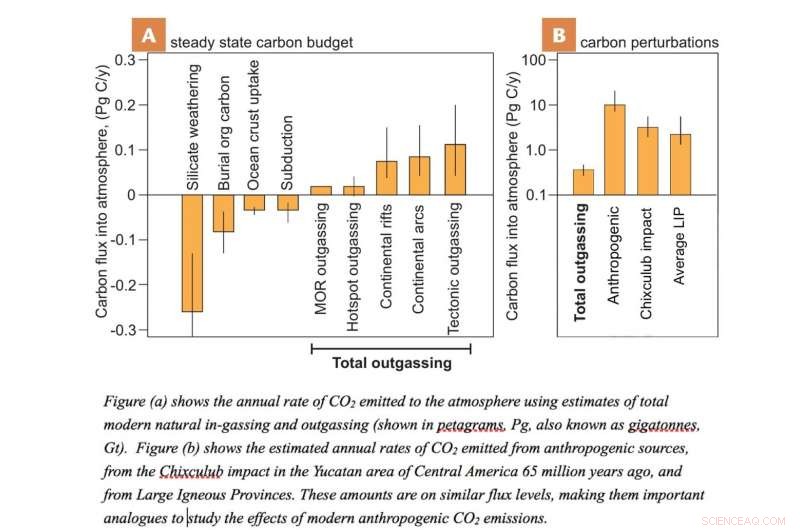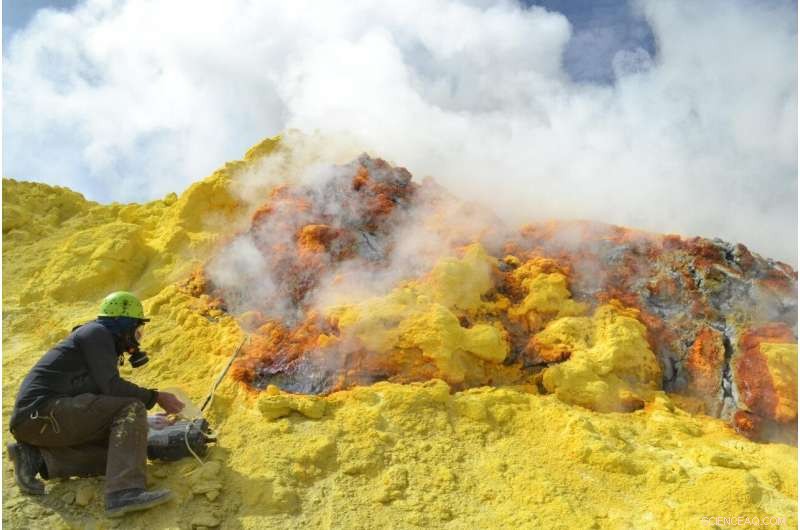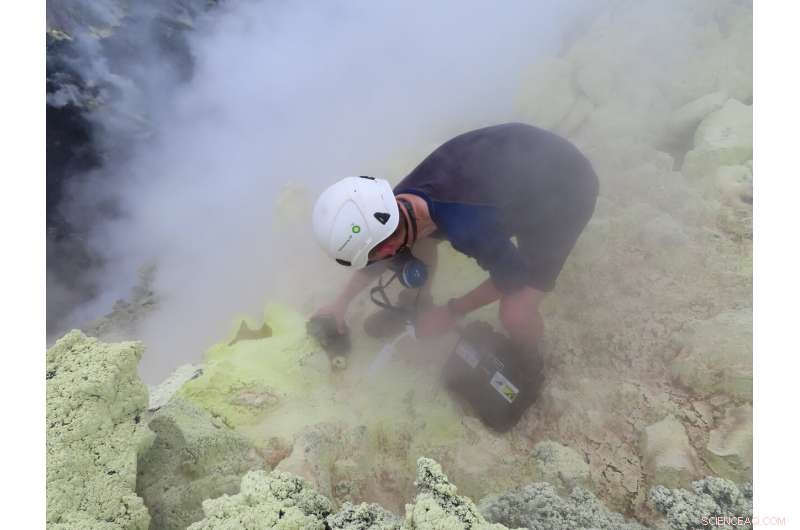
Histogramas de entrada de carbono (valores positivos) y salida (valores negativos) a la atmósfera y los océanos. Las unidades están en Pg C / año. (A) Flujos de carbono basados en modelos de estado estacionario. Abreviaturas:MOR =dorsal oceánica; org carbono =carbono orgánico. (B) Flujos de carbono como resultado de perturbaciones a gran escala del ciclo del carbono. La desgasificación total se refiere a los eventos enumerados en la Figura 2A; antropogénico son las contribuciones humanas; Chicxulub (México) se refiere al impacto de un asteroide al final del Cretácico y la extinción masiva resultante; LIP promedio se refiere a la entrada de grandes provincias ígneas. Los datos de Kawaragi et al. (2009), Lee y col. (2019) y Black y Gibson (2019) Crédito:Deep Carbon Observatory
Volcanes colisionando y extendiendo placas continentales y oceánicas, y otros fenómenos re-estudiados con herramientas innovadoras de alta tecnología, proporcionar información nueva e importante sobre el funcionamiento más interno de la Tierra, dicen los científicos.
Preparándose para resumir y celebrar el programa del Observatorio de Carbono Profundo de 10 años en la Academia Nacional de Ciencias, Washington DC, 24-26 de octubre El equipo de Reservorios y Flujos de 500 miembros de DCO describió hoy varios hallazgos clave que abarcan desde el presente hasta los miles de millones de años pasados; desde el núcleo de la Tierra hasta su atmósfera, y en tamaño desde volcanes individuales hasta los cinco continentes.
Entre muchos hallazgos de amplio alcance, resumido y resumido en una serie de artículos publicados en la revista Elementos:
Dice la científica de la DCO Marie Edmonds de la Universidad de Cambridge, Reino Unido:"Carbon, la base de toda la vida y la fuente de energía vital para la humanidad, se mueve a través de este planeta desde su manto hasta la atmósfera. Para asegurar un futuro sostenible, es de suma importancia que comprendamos todo el ciclo del carbono de la Tierra ".
"La clave para desentrañar el ciclo natural del carbono del planeta es cuantificar cuánto carbono hay y dónde, cuánto se mueve (el flujo) y qué tan rápido, desde los reservorios de la Tierra Profunda hasta la superficie y viceversa ".
Agrega a su colega Tobias Fischer de la Universidad de Nuevo México, EE.UU .:"El Observatorio de Carbono Profundo ha avanzado en la comprensión del funcionamiento interno de la Tierra. Su cuerpo colectivo de más de 1500 publicaciones no solo ha aumentado lo que se conoce sino que ha establecido límites a lo que se puede conocer, y quizás incognoscible ".
"Mientras celebramos el progreso, subrayamos que la Tierra profunda sigue siendo una frontera científica altamente impredecible; realmente sólo hemos comenzado a hacer mella en los límites actuales de nuestro conocimiento ".
¿Cuánto carbono contiene la Tierra?
Los científicos saben desde hace mucho tiempo que el carbono dentro de la Tierra existe como una variedad diversa de sólidos, fluidos y gases. Algunos de estos materiales involucran combinaciones de carbono con oxígeno (por ejemplo, dióxido de carbono), con hierro (por ejemplo, carburos), con hidrógeno (por ejemplo, kerógeno carbón, petróleo, y metano), y otros elementos (por ejemplo, silicio, azufre, y nitrógeno), además del carbono elemental (p. ej., grafito y diamante).
Los científicos del Observatorio de Carbono Profundo subrayan que el conocimiento del carbono total en el manto inferior y el núcleo todavía es especulativo y los números seguramente evolucionarán en precisión a medida que continúe la investigación. Dicho eso expertos (especialmente Lee et al ., 2019) estiman los reservorios de carbono en la Tierra de la siguiente manera:
En cifras:mejores estimaciones actuales, carbono en la tierra
1,85 mil millones de gigatoneladas (1,85 x 1 mil millones x 1 mil millones de toneladas):carbono total en la Tierra

Muestreo de gas en el volcán Lastarria (norte de Chile) durante la expedición Trail by Fire (trailbyfire.org) Crédito:Yves Moussallam, Observatorio de la Tierra Lamont Doherty
Desglose:
Release of CO 2 de los volcanes
Earth's total annual out-gassing of CO 2 via volcanoes and through other geological processes such as the heating of limestone in mountain belts is newly estimated by DCO experts at roughly 300 to 400 million metric tonnes (0.3 to 0.4 Gt).
Volcanoes and volcanic regions alone outgas an estimated 280-360 million tonnes (0.28 to 0.36 Gt) of CO 2 por año. This includes the CO 2 contribution from active volcanic vents, from the diffuse, widespread release of CO 2 through soils, faults, and fractures in volcanic regions, volcanic lakes, and from the mid-ocean ridge system.
In many world regions, tectonic outgassing (emissions from mountain belts and other plate boundaries), particularly in cool night temperatures, can cause dangerous levels of CO 2 close to the ground—enough to suffocate livestock.
According to DCO researchers, with rare exceptions over millions of years the quantity of carbon released from Earth's mantle has been in relative balance with the quantity returned through the downward subduction of tectonic plates and other processes.
Carbon catastrophes
While the volume of carbon buried through subduction and what's released from volcanoes and tectonic fractures are normally in steady state, about four times over the past 500 million years this balance has been upended by the emergence of large volcanic events—1 million or more square kilometers (the area of Canada) of magma released within a timeframe of a few tens of thousands of years up to 1 million years.
These "large igneous provinces" degassed enormous volumes of carbon (estimated at up to 30, 000 Gt—equal to about 70% of the estimated 43, 500 Gt of carbon above surface today).
Carbon cycle imbalance can cause rapid global warming, changes to the silicate weathering rate, changes to the hydrologic cycle, and overall rapid habitat changes that can cause mass extinction as the Earth rebalances itself.
Similar carbon catastrophes have been caused by asteroids / meteors (bolides), such as the massive Chixculub impact in the Yucatan area of Central America 65 million years ago—an event to which extinction of the dinosaurs and most other plants and animals of the time has been attributed.

Year-round monitoring at five volcanoes revealed that the level of carbon dioxide relative to sulfur dioxide in volcanic gases systematically changes in the hours to months before an eruption. Here Deep Carbon Observatory volcanologist Brendan McCormick installs a DECADE (Deep Earth Carbon DEgassing) subgroup MultiGAS monitoring device at Rabaul Volcano, Papúa Nueva Guinea. Credit:Emma Liu, University of Cambridge
According to Australian researchers Balz Kamber and Joseph Petrus:"The Chicxulub event ... greatly disrupted the budget of climate-active gases in the atmosphere, leading to short-term abrupt cooling and medium-term strong warming."
"Thus, some large bolide impacts are comparable to those observed in the Anthropocene in terms of rapidly disrupting the C (carbon) cycle and potentially exceeding a critical size of perturbation."
Wiring up volcanoes
DCO experts estimate that about 400 of the 1500 volcanoes active since the last Ice Age 11, 700 years ago are venting CO 2 hoy dia. Another 670 could be producing diffuse emissions, with 102 already documented. De estos, 22 ancient volcanoes that have not erupted since Pleistocene epoch (2.5 million years ago to the Ice Age) are outgassing. Thus all volcanoes, the young and very old, may be emitting CO 2 .
Today's CO 2 , sulphur dioxide and hydrogen sulphide emissions rates are now quantified for many of the world's most active volcanoes thanks in part to the development of miniature, durable, inexpensive instruments.
And several volcanoes have been wired up with permanent gas instrument monitoring stations to obtain real time data readings, improving monitoring by governments and universities in the U.S., Italia, Costa Rica, y en otros lugares. About 30 collaboratively operated gas-monitoring stations on volcanoes across five continents now exist, which continually monitor emissions.
Pioneered by scientists with DCO's DECADE (Deep Earth Carbon DEgassing) subgroup, the technologies and installations have helped revolutionize data collection within inaccessible or dangerous volcanic places. The data obtained are combined with readings from long-established ground and satellite systems.
Recent research has revealed the number of volcanoes thought to be out-gassing measurable amounts of CO 2 hoy dia. Estimated at 150 in 2013, DECADE researchers confirm that more than 200 volcanic systems emitted measurable volumes of CO 2 between the years 2005 and 2017. Of these, several super-regions of diffuse degassing have been documented (e.g., Yellowstone, NOSOTROS., the East African Rift, África, and the Technong volcanic province in China, to name a few). Diffuse degassing is now recognized as a CO 2 source comparable to active volcanic vents.
Among the DCO's legacies:a new database (http://www.magadb.net) to capture information on CO 2 fluxes from volcanic and non-volcanic sources around the world.
Volcanic whispers:Changes in ratio of vented SO2 to CO 2 can forewarn of eruptions
Research at a growing number of well-monitored volcanoes worldwide has provided important new insight about the timing of eruptions relative to the composition of volcanic outgassing.
Year-round monitoring at five volcanoes revealed that the level of carbon dioxide relative to sulfur dioxide in volcanic gases systematically changes in the hours to months before an eruption. Volcanoes where such patterns have been documented include Poas (Costa Rica), Etna and Stromboli (Italy), Villarica (Chile), and Masaya (Nicaragua).
Likewise the CO 2 to SO2 ratio changed dramatically months to years prior to large eruptions at Kilauea (Hawaii) and Redoubt Volcano (Alaska), in the U.S., suggesting that monitoring gas composition, often in invisible plumes, offers a new eruption forecasting tool that, en algunos casos, precedes increases in volcano seismicity or ground deformation.